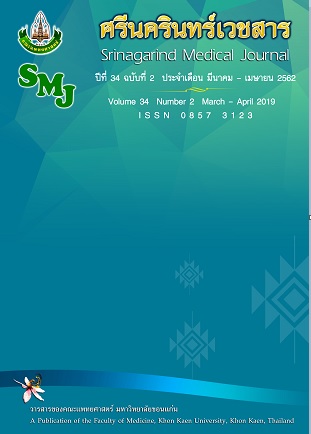Selected Factors Influencing Risk Management for Workplace Violence of Registered Nurses Working at Regional Hospitals in the Northeast of Thailand
Keywords:
Selected factors; Risk Management for Workplace Violence; Registered Nurses; Regional hospitals in the Northeast of Thailand.Abstract
Background and Objective: At present, risk of workplace violences associated with nurses is increasing. Risk violences include verbal and physical violences. When it occurs, it could affects nurses both body and mind, image of the hospital, including nursing profession. Appropriate management of risk violence in the workplace could enhance patient and nurse safety. The purposes of this descriptive research were to study level of risk management (RM) for workplace violence and to study selected factors that could predict RM for workplace violence by registered nurses (RNs) working in regional hospitals in the Northeast of Thailand.
Methods: This descriptive research was to study in 241 RNs samples working in Regional Hospitals in the Northeast of Thailand. The study instruments were questionnaires asking for 1) personal factors (demographic data and attitude of RM) 2) organizational factors and 3) RM for workplace violence. Reliability testing of organizational factors and the RM for workplace violence was done and computed by Cronbach's alpha coefficient equal to 0.92 and 0.94, respectively. Data were analyzed and presented as frequency, percentage, mean, standard deviation, Pearson Product Moment Correlation Coefficient and Stepwise Multiple Regression Analysis.
Results: Overall, the level of RM for workplace violence by RN was high (x̄=3.81, S.D.= ± 0.78). Factors related to RM were: personal factor (time to provide services, training of RM and attitude of RM) which r=-.153, r=.622, r=.483 respectively, organizational factors (safety culture and participative management) which r=.632 and r=.533. Significant predictive factors of RM for workplace violence were personal factor (attitude), organizational factors as safety culture (work assignment and supporting team), and participative management. These predictors could be used to predict the RM for workplace violence and together explained 47 percent of variance.
Conclusion: Significant selected factors to predict the RM for workplace violence were personal factor (attitude), organizational factors as safety culture (work assignment and supporting team), and participative management.
References
2. สุพรรณี พุ่มแฟง, บุญใจ ศรีสถิตนรากูร. ปัจจัยที่ทำให้เกิดความเครียดในงานของพยาบาลวิชาชีพ โรงพยาบาลตติยภูมิ.วารสารเกื้อการุณย์ 2558; 22: 140–53.
3. Talas MS, Kocaöz S, Akgüç S. A survey of violence against staff working in the emergency department in ankara, Turkey. Asian Nurs Res (Korean Soc Nurs Sci) 2011; 5: 197–203.
4. Speroni KG, Fitch T, Dawson E, Dugan L, Atherton M. Incidence and cost of nurse workplace violence perpetrated by hospital patients or patient visitors. J EmergNurs 2014; 40: 218–28; quiz 295.
5. Morphet J, Griffiths D, Plummer V, Innes K, Fairhall R, Beattie J. At the crossroads of violence and aggression in the emergency department: perspectives of Australian emergency nurses. Aust Health Rev 2014; 38: 194–201.
6. ศิมาลักษณ์ ดิถีสวัสดิ์เวทย์.ความรุนแรงจากการทำงานที่มีต่อพยาบาล: อัตราและผลกระทบต่อความตั้งใจออกจากวิชาชีพพยาบาล. กรุงเทพมหานคร : ฐานข้อมูลโครงสร้างพื้นฐานภาครัฐด้านวิทยาศาสตร์และเทคโนโลยี กระทรวงวิทยาศาสตร์และเทคโนโลยี; 2552.
7. Phillips JP. Workplace Violence against Health Care Workers in the United States. New England journal of medicine 2016; 374: 1661–9.
8. วันเพ็ญ ไสไหม, สุดาพรรณ ธัญจิรา, ณวีร์ชยา ประเสริฐสุขจินดา. ความรุนแรงในสถานที่ทำงานและการจัดการของบุคลากรทางการพยาบาล หน่วยงานอุบัติเหตุและฉุกเฉิน. รามาธิบดีพยาบาลสาร 2553; 16: 121–35.
9. Gabrovec B, Eržen I. Prevalence of violence towards nursing staff in Slovenian nursing homes. Slovenian J Public Health 2016; 55: 212–7.
10. Boafo IM, Hancock P. Workplace violence against nurses: a cross-sectional descriptive study of Ghanaian nurses. Sage Open [serial online] 2014 Mar 24 [cited 2016 Mar 1]; [9 screens]. Available from:https://bit.ly/2LnJNBa
11. Wilson J, Tingle J, editors. Clinical risk modification: a route to clinical governance? Oxford: Butterworth-Heinemann, 1999.
12. ประไพรัตน์ ไวทยกุล, ลัดดา กิจนพศรี, ธนวรรธน์ ยอดบุรี, จักรฤษณ์ สนอ่อง, ปราการ นทีประสิทธิพร, อิทธิชัย อ่อนน้อม และคณะ.ปัจจัยส่วนบุคคลและทัศนคติของบุคลากรที่เป็นคณะกรรมการบริหารความเสี่ยงของคณะหน่วยงานที่มีต่อกระบวนการจัดทำบริหารความเสี่ยงของมหาวิทยาลัยนเรศวร. วารสารวิชาการ ปขมท 2556; 2: 33– 40.
13. พวงผกา ไทยดำรงค์, ทวนทอง เชาวกีรติพงศ์ , ชูชีพ พุทธประเสริฐ.อุบัติการณ์สาเหตุของความเสี่ยงและปัจจัยที่เกี่ยวกับการบริหารความเสี่ยงในโรงพยาบาลศูนย์และโรงพยาบาลทั่วไป.พุทธชินราชเวชสาร2556; 30: 329-39.
14. เพ็ญนภา เส้งซ้าย. โมเดลเชิงสาเหตุการบริหารความเสี่ยงของโรงพยาบาลสงขลานครินทร์วารสารเศรษฐศาสตร์และบริหารธุรกิจมหาวิทยาลัยทักษิณ 2553; 5: 39-49.
15. เชาวรัตน์ ศรีวสุธา. ปัจจัยที่มีผลต่อการบริหารความเสี่ยงด้านคลินิกของพยาบาลวิชาชีพใน โรงพยาบาลเอกชนแห่งหนึ่ง ในจังหวัดนนทบุรี. วารสารโรงพยาบาลเจริญกรุงประชารักษ์ 2558; 11: 31-45.
16. พจนา รุ่งรัตน์. ความสัมพันธ์ระหว่างปัจจัยส่วนบุคคล ความรู้และทัศนคติเรื่องการบริหารความเสี่ยงกับการปฏิบัติตามกระบวนการบริหารความเสี่ยงของบุคลากรทางการพยาบาล โรงพยาบาลบ้านค่าย จังหวัดระยอง. วารสารวิทยาลัยพยาบาลพระปกเกล้า จันทบุรี 2557; 25: 73–84.
17. วริศรา ดิษบรรจง, วีระพร ศุทธากรณ์, ธานี แก้วธรรมานุกูล. สิ่งแวดล้อมในการทำงานและความรุนแรงในสถานที่ทำงานของบุคลากรทางการพยาบาล. วารสารพยาบาลทหารบก 2552; 10: 32–42.
18. Polit, DF, Beck, CT. Nursing research: Principles and methods. Lippincott Williams & Wilkins, 2004.
19. บุญใจศรีสถิตนรากูร.ระเบียบวิธีวิจัยทางพยาบาลศาสตร์.พิมพ์ครั้งที่ 5.กรุงเทพมหานคร:ยูแอนด์ไออินเตอร์มีเดีย. 2553 .
20. จันทนา มะโนวัฒนา . ความรุนแรงในสถานที่ทำงานในโรงพยาบาลของรัฐ จังหวัดราชบุรี.
กรุงเทพมหานคร : มหาวิทยาลัยมหิดล; 2552.
21. ทรียาพรรณ สุภามณี, วิภาดาคุณาวิกติกุล, ผ่องศรีเกียรติเลิศนภา. การปฏิบัติงานเกินเวลาของพยาบาลและ ผลลัพธ์ด้านพยาบาลในโรงพยาบาลชุมชน.พยาบาลสาร 2557; 41: 48-58.
22. สภาการพยาบาล. ประกาศสภาการพยาบาลเรื่องมาตรฐานบริการการพยาบาลและการผดุง-ครรภ์ระดับทุติยภูมิ.นนทบุรี : สภาการพยาบาล. 2557.




